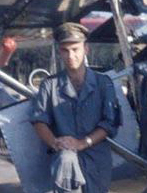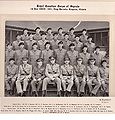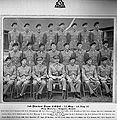Strain, EM
| EM (Ted) Strain | |
|---|---|
 | |
| Nickname | Ted |
| Allegiance | Canada |
| Service/branch | Canadian Army |
| Rank | Lieutenant |
His Pilot’s Story[1]
I was born in Toronto December 18, 1935. Our family moved to Winnipeg in 1941 when my father returned from overseas. In 1951 we moved back to Toronto where I finished my High School and was admitted to the University of Toronto in Engineering Physics in 1953. I enrolled in the Regular Officer Training Plan (ROTP) in 1954 and spent summers training at Vimy Barracks in Barryfield, Ontario. After graduating in the spring of 1957, I was assigned to J Troop supporting the PPCLI in Calgary. I spent the summer in Wainwright Alberta on exercises, was married at the end of the summer, and then spent some time back at Vimy on courses.
When the opportunity to apply for flight training arose, I jumped at the chance. I spent the summer of 1958 in Wainwright anxiously awaiting word to find out if I had been accepted. Finally it came - I was to report for the final tests. Our first child was due during the assigned time, but I was determined to get into the program, so I left two sets of (future) grandparents in charge and reported for the testing. I passed the tests and returned home to meet my son.
I commenced flight training at the Brandon Flying Club on Feb 27, 1959, on Cessna 140 aircraft. I solo'd after about 6 hrs. of training, and we went on to the Link trainer, and a Cessna 172 before the "private" training was complete in early May. Training then moved to the base at Rivers, Manitoba on the L19 aircraft. Winters in Brandon and Rivers are cold and windy, and I notice from my Log Book that we did a lot more flying in the June to August period than we did earlier.
In early August, two of our instructors, Stan Hand and Verne Taskey accompanied us on a cross-country trip to Petawawa, Ontario. Our route was to be Rivers, Winnipeg, Kenora, Armstrong, Earlton, and down the Ottawa valley to Petawawa. We were flying in a loose in-line formation as we went down the valley, with the ceiling closing down and the hills getting higher on each side of the river. Finally the only ground I could see was the tops of trees, straight below me. This was very disorienting, so as I gave it up and looked up to fly on instruments, we all flew straight into a wall of black clouds rolling up the valley. One of the instructors came on the radio to tell us to return to North Bay, and that we were to peel out of line at five minute intervals to avoid any close encounters. Since I was near the front, I got some instrument time in waiting my turn. When I came out of the cloud bank heading back west I was at 5000 ft. altitude - a bit of an excessive response since the hills were only a few hundred feet in height. I was obviously very relieved to be in the clear, and not thinking clearly, since as I approached the air base I called on the radio "Rivers tower, Rivers tower, this is Army 714, request landing instructions". There was silence for a moment, and then a sardonic voice said "Army 714, this is North Bay tower - I doubt if Rivers can hear you from here." We all had a drink or two in the mess that night.
In October I was selected to go on a "Summer Survival Course" at the Air Force survival school in Edmonton. After a few days in the classroom, we headed out to a camp near Hinton, Alberta, in the foothills of the mountains. That particular fall, summer had given up long ago, and as we were issued our lightweight sleeping bags and tents in the best military tradition, the temperature was 10 below zero. We spent an interesting few days in the bush snaring rabbits, etc. Each group was issued a shotgun with one shell each, and told to hunt only in pairs to avoid getting lost alone. Since the local game birds were continually chased around in the camp area, they were very wary and hard to find. I finally got a grouse, the only one to do so, by ignoring the instructions and hunting more quietly by myself. At the end of the course, I won the "Most Likely to Survive" award, which I can only attribute to disobeying instructions.
In the spring of 1960, I very reluctantly came to the decision that I would leave the military and pursue a career in electronics. As a result, I was part of a group who designed the first general purpose timesharing computer in the world. I went from there to become President of Motorola Canada from which position I retired in 1990. My son and I are now (2002) engaged in building catamaran sailboats which keeps me busy and out of trouble.
I very much enjoyed and was rewarded by my time in the Signal Corps, and the time spent flying is among my fondest memories.
Related Pages
- No related pages at this time


